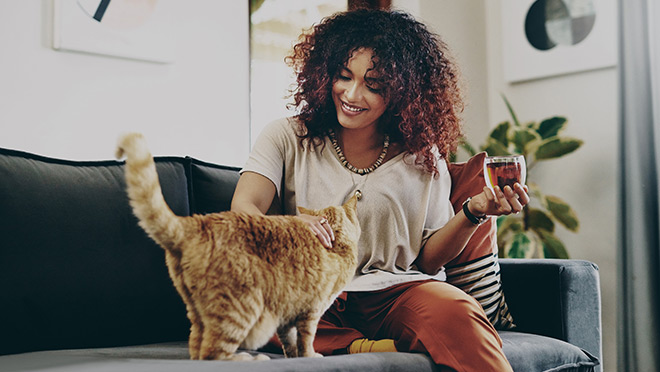6 ways to make pet ownership a more sustainable choice

Where you get your pets, and what you feed them, adds up
Yes, adding a pet to your household is a more sustainable choice than adding a kid to the mix. But just how much more sustainable is really up to you and a range of decisions you make, from where you get your pet, to what you feed it, to how you deal with all that poop.
In the lead-up to Earth Day 2022 – and National Pet Day on April 11 – here are six ways to be a more sustainable pet owner:
1. Get a rescue dog or cat
The call went out last November as B.C.'s animal shelters reached capacity. The message was, and still is: if at all possible, opt for a rescue dog or cat rather than sourcing and paying for the pick of the litter of the breed at the top of your list.
Why? While pets are handed to shelters by families unable, unwilling, or without the income to support them, the demand for designer puppies, in particular, is creating more pets than we can sustain. By adopting, you're not just providing a home for a deserving animal, you're also freeing up space for another animal in need. And you could save an animal's life.
As is the case with selecting a pet from a breeder, consider your personality and lifestyle, such as the amount of time you can spend at home or training your dog, as you look for a rescue pet.
2. Carefully consider what you feed your pet
Some studies have attached a huge carbon footprint to dog and cat consumption of meat, while other studies have found a negligible impact. And some research attaches positive overall impacts associated with pet ownership, as owners are more likely to spend time walking and less likely to take vacations involving flights.
But some pet foods are more sustainable than others, and you may want to resist the trend toward feeding your pet a raw meat diet, which is likely to carry a higher CO2 footprint. And the production, packaging, and shipping of all foods, including pet foods, carries a large footprint. A 2018 study estimated the global pet food market at $94 billion US.
Some general advice from experts around buying food for pets:
- Buy pet food in bulk as much as possible, which cuts down on preparation and packing costs.
- If possible, opt for a local brand of pet food purchased from a locally-owned pet store. This will help cut down on the greenhouse gas emissions associated with shipping products long distances, and you'll be supporting local businesses.
- Go for food-grade meat byproducts rather than prime cuts. Most studies show no special benefit to pets from eating the cuts of muscle that we prefer. And meats like steaks and chicken breast are less nutritious than the organ meats included in many pet foods.
- Avoid canned food, which can include toxins that can sicken your pet.
3. Make your feline an indoor cat, or opt for leashed walks
The feral aspect of a cat kicks in when it spends a lot of time outdoors, and birds are often the losers when that happens. Cats' natural drive to hunt can put considerable pressure on wildlife, especially during nesting season, and there's a good chance you have no idea how much your cat is killing. A University of Georgia study found that 77% of wildlife caught by cats is either eaten or left at the site of capture.
One option to give your cat time outdoors is to get them accustomed to being walked on a leash attached to a well-fitted harness. This will keep them safe and prevent issues with wildlife.
Leashed walks aren't for everyone (or every cat). The bonus in keeping your cat indoors? They generally live longer than outdoor cats.
4. Pick up after your dog, and use biodegradable bags
Pet feces carry bacteria that can be harmful and have shown to be a persistent source of bacterial pollution in streams, rivers, and lakes. Back in 1991, the Environmental Protection Agency in the U.S. put dog feces in the same category of pollutants as oil, herbicides, and insecticides.
If you want to really do the right thing, carefully construct a DIY dog or cat composter. It will need to be separate from your other compost, carefully constructed, and experts recommend waiting at least 18 months for the feces to fully decompose. Once it's composted, use it only on shade trees, shrubs, houseplants, and other non-edible plants.
Avoid using cat litter that includes clay, in part due to the potentially harmful effects it can have on your cats (feline asthma, internal blockages from ingested litter), and potentially on humans.
5. Keep the cat bling to a minimum
When pet stores start rivaling the number of coffee shops in some neighbourhoods, you know there's a growing consumption issue among pet owners. There are so many cute things to buy pets, but experts suggest keeping it simple. Resist buying plastic toys and other pet products that take an environmental toll.
6. Spay or neuter your pets
The world doesn't need more puppies and kittens. An estimated 70,000 are born each day in the U.S., and it's leading to an overabundance illustrated by the tens of thousands of pets who wind up in shelters.
With fewer pets out there, overpopulation in shelters decreases along with animal abuse and euthanization rates. Food, energy, and resources are decreased, and spaying or neutering your pet drastically reduces their risk of cancer.
Related: